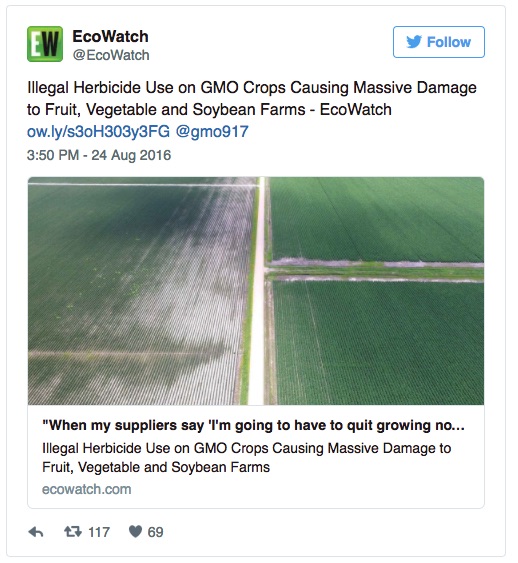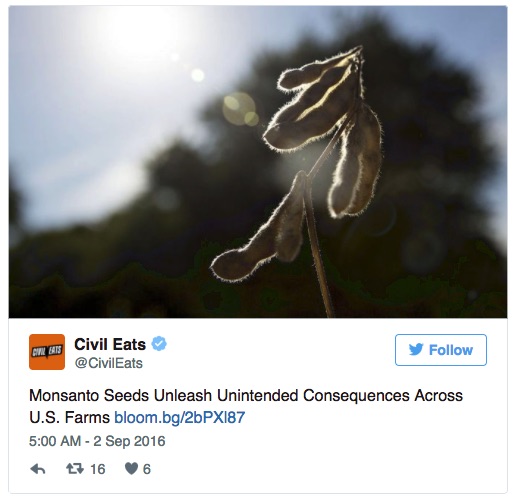To the horror of farmers across America’s farm belt, hundreds of thousands of crop acres have been adversely impacted by the apparent misuse of the drift-prone herbicide dicamba onMonsanto’s Roundup Ready Xtend soybean and cotton plants.

Purdue
According to a recent U.S. Environmental Protection Agency (EPA) compliance advisory, the EPA and state agencies have received an “unusually high” number of reports of crop damage that appear related to the illegal spraying of dicamba.
The EPA has collected similar reports of crop damage from 10 states: Missouri, Alabama, Arkansas, Illinois, Kentucky, Minnesota, Mississippi, North Carolina, Tennessee and Texas.
Missouri appears to have suffered the most. According to the Southeast Missourian, the state’s department of agriculture has received 125 complaints of dicamba damage on more than 40,000 crop acres.
Missouri farmers have reported damage on a number of crops including peaches, tomatoes, cantaloupes, watermelons, rice, cotton, peas, peanuts, alfalfa and soybeans, the EPA said.

The reason behind this widespread crop damage is that while Monsanto’s genetically modified(GMO) crops can withstand sprays of dicamba, other crops cannot. The seed company decided to sell its new dicamba-tolerant seeds to farmers before gaining federal approval for the herbicide specifically designed to go with the seeds—DuPont FeXapan herbicide plus VaporGrip Technology—which is supposed to reduce dicamba’s volatility and drift damage.
While Monsanto has warned farmers not to do so, farmers are illegally spraying their GMO soybeans and cotton with older formulas of dicamba to beat back weeds. Dicamba’s over-the-top usage for the growing of cotton or soybean plants has not been approved by the EPA. Any farmer who sprays this herbicide over their dicamba-tolerant crops are breaking the law and can face fines of $1,000.
During a Wednesday hearing at Missouri’s House Select Committee on Agriculture, Duane Simpson, who heads Monsanto’s U.S. state and local government affairs team, said, “Monsanto, like all of you, is concerned about the damage we are seeing due to the alleged illegal misuse of pesticides.”
According to the Southeast Missourian, Simpson said that once the new herbicide is approved by the EPA, Monsanto will offer general training with dealers, applicators and farmers on the proper way to use dicamba.

However, some farmers feel they have no choice but to buy Monsanto’s dicamba-tolerant crops just to protect their crops from drift. As Bloomberg described:
For folks like Landon Hayes, who grows earlier-generation soybeans in Campbell, Missouri, the consequences have been costly. He says 500 acres of his crops were damaged this summer by stray wisps of dicamba. And now he feels compelled to buy the engineered Monsanto seeds to avoid injury next season.
“They knew that people would buy it just to protect themselves,” Hayes says. “You’re pretty well going to have to. It’s a good marketing strategy, I guess. It kind of sucks for us.”
The dicamba problem is not going away anytime soon. Reuters reported that Xtend soybeans were planted on 1 million acres in the U.S. this year, but Monsanto expects 15 million acres to be planted with the GMO soybeans next season and 55 million acres by 2019.
“If the EPA doesn’t do something, that means every farmer needs to buy Xtend to protect themselves from their neighbor,” Sanford C. Bernstein & Co. analyst Jonas Oxgaard told Bloomberg.
In response, Monsanto spokeswoman Christi Dixon told Bloomberg it is “absolutely false” that her firm engineered the problem for profit, adding that the company took “extensive steps” to warn farmers of illegal dicamba use.
